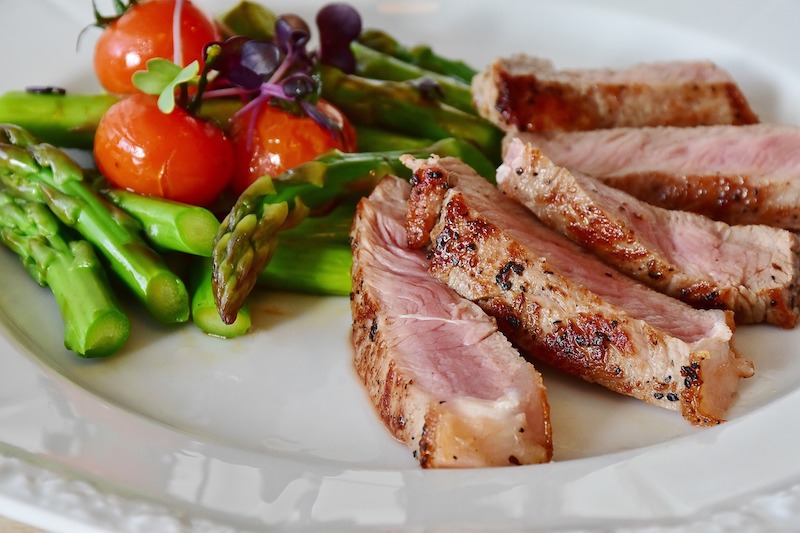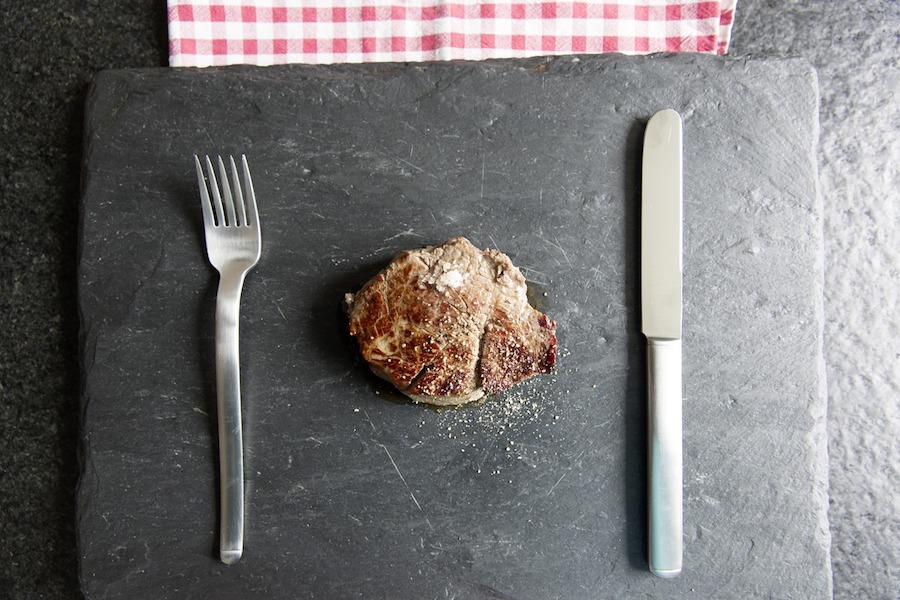One of the hottest and diets around and one that’s especially popular among functional fitness athletes, the Paleo diet — sometimes called the Paleolithic or Caveman diet — focuses on nutrient-dense foods and tends to be higher in fat and protein and lower in carbohydrates than the standard American diet.
While it’s got its detractors — U.S. News & World Report consistently ranks it the worst diet ever — there’s plenty of data suggesting that it may be beneficial for weight loss, nutrient intake, and more.
This article is BarBend’s complete introduction to the Paleo diet and features input from two registered dietitians and a solid two dozen scientific studies. Here, we’re going to cover
- The Paleo Diet Rules
- What Is and Isn’t a “Whole Food”
- Why Paleo Emphasizes Fat
- The Pros & Cons of Paleo
Whether you’re a fan or a skeptic, you’re going to learn something today.
Editor’s note: The content on BarBend is meant to be informative in nature, but it should not be taken as medical advice. The opinions and articles on this site are not intended for use as diagnosis, prevention, and/or treatment of health problems.
Paleo Diet Rules
- Leans primarily on meat, vegetables, fruits, nuts, and seeds
- Wild and/or pasture raised meat and produce is preferred
- Some proponents allow dairy and white potatoes
There’s no Paleo, Inc. that’s closely monitoring and assigning definitions to the term, but there are a lot of influential figureheads in the community like Mark Sisson, Chris Kresser, Robb Wolf, and Dr. Loren Cordain, who actually trademarked the words “The Paleo Diet.”
Nonetheless, there remains some variance in how the diet is practiced by its adherents and what is and isn’t generally considered acceptable to eat has changed somewhat throughout the years.
Whole Foods
The central thesis is to eat like a caveman. Specifically, whatever was available to humans before the advent of agriculture came along and we started farming grains, legumes, and other foods that are restricted on the Paleo diet.
That means meat — ideally wild, free roaming, grass-fed, and/or pasture-raised — vegetables, fruit, nuts, and seeds. Under no circumstances should you consume wheat, corn, soy, or legumes.
Then there’s the “maybe” category. Depending on who you ask, honey is fine, grass-fed dairy is acceptable, and white potatoes might be allowed. (This is in stark contrast to sweet potatoes, which belong to a different family of plants and are universally accepted on Paleo.) Some subsections of the Paleo community allow grain-like foods like quinoa and buckwheat and, extremely rarely, white rice. Note that this is quite uncommon: the party line is usually meat, vegetables, fruit, and nuts.
[Learn more about the differences between grass-fed and grain-fed beef here!]
Fats
Advocates are typically pro-fat: saturated fat and cholesterol are welcome additions to the plate. Processed seed and vegetable oils (like soybean, corn, and canola) are forbidden, though grass-fed butter and fruit oils like olive oil, avocado oil, coconut oil, and palm are typically allowed.
These categories may seem arbitrary — cavemen weren’t exactly manufacturing avocado oil, after all — but the reasoning usually relies on the quality of fats present.
The argument largely hinges on polyunsaturated fats: processed oils and conventionally raised meat, dairy, and fish tend to be higher in Omega-6 fatty acids than their more Paleo-friendly counterparts. The kinds of Omega fatty acids we consume have been implicated in a range of health effects: consuming too much Omega-6 and not enough Omega-3 may increase inflammation, lower immunity, and maybe even affect mental health.(1)(2)(3)(4)(5) Research published in Oxidative Medicine and Cellular Longevity in 2016, for example, found that in addition to the anti-inflammatory effects, Omega-3s play an “important role on the structural changing of the brain” and could impact depression risk, while noting that plenty of lifestyle and other factors also play an important role, here.(6)
While Paleo advocates invariably promote the healthfulness of Paleo fats, it’s worth pointing out that you can follow a lower fat, higher carb diet by combining foods like fish, chicken, sweet potato, bananas, and so on. Nonetheless, Paleo is grain free and leans toward higher fat foods overall.
[Learn more in our complete guide to the best Omega-3 supplements!]
The Pros & Cons of Paleo
Pro: It’s Nutrient Dense
- Paleo eliminates practically all “junk” food in favor of nutrient dense whole foods.
“One upside to the Paleo diet is that it can be nutritionally dense,” says Leyla Shamayeva, MS, RD, a New York-based dietitian. “If you’re emphasizing vegetables, fruit, lean meat, and nuts, you’re getting important micronutrients and antioxidants.”
This is one of the biggest upsides of Paleo: when so many foods are simply off limits and with your only food options as wild (or wild-ish) animals, vegetables, fruit, and nuts, you’re not going to be filling your belly with sugar or processed food. You’re going to be consuming a lot of vitamins and minerals. That’s certainly not to say that processed food is always bad, only that the least nutrient dense junk foods you can buy are pretty much left off of the list.
Con: It’s Super, Super Restrictive
- The Paleo diet is hard to stick to, which calls its usefulness into question.
The best diet is the one you can stick to, and the more restrictive it is, the harder a diet is to stick to. Avoiding so many common foods can lead to burnout, not to mention the fact that it will likely require more time preparing your own food — and some 90 percent of Americans don’t like to cook.
[If that sounds like you, check out our guide to the best Paleo meal delivery services.]
“For most people, making an elimination diet your lifestyle diet isn’t sustainable, especially in this case because whole grains and legumes are everywhere — and good for you!” says Shamayeva. “Omitting such foods with health benefits definitely draws the diet’s usefulness into question.”
“You have to avoid all dairy, beans, legumes, grains and sugar. I tend to believe in an everything in moderation approach to eating, and this is too restrictive for my taste,” adds New York-based registered dietitian Natalie Rizzo MS, RD. “Imagine not having cake or a beer on your birthday!”
The typical argument against grains and legumes is that they have “antinutrients” like phytic acid, which bind to minerals like magnesium and iron and make it harder to absorb them.(7)(8) However, this effect is either weakened or totally nullified if you’re accompanying phytic acid with Vitamin C, plus phytic acid is an antioxidant that’s been linked to lower risks of cancer, cardiovascular disease, and kidney stones.(9)(10)(11)(12)(13) There’s probably no real reason to nix grains and legumes unless you have sensitivities.
The restrictiveness might also lead to feelings of guilt when you slip up, Shamayeva adds.
“Elimination diets are very likely to lead to feelings of guilt, obsession, and pressure when you eat a food on the “do not eat” list. Balance is key, and elimination diets don’t leave much room for it.”
Then again, it does help a lot of people stay away from foods that make them prone to gain weight…
Pro: Paleo Probably Helps With Weight Loss
- Paleo restricts food groups, which naturally restricts calories and typically leads to weight loss.
Sure, there’s a lot to be said about how eating more anti-inflammatory foods might help with weight loss, but far and away the most important part of losing weight is calorie balance: eating less than you burn. The simple fact that you can’t have that ice cream and can’t eat a bag of chips means you’re less likely to overeat on junk.
“The majority of foods you can eat are actually really healthy, like chicken, fish, nuts, vegetables and fat,” says Rizzo. “Since you’re omitting so many things from your diet, you will likely lose weight.”
Of course, you can always go ahead and make Paleo desserts that are jam packed with almond flour and coconut oil, which can easily add a fast thousand calories to your total. Generally speaking, though, fat and protein are more satiating than simple carbohydrates and quite a few studies have found that folks following Paleo diets wind up eating significantly less and losing weight, even when they’re not tracking their intake.(14)(15)(16)
Con: It’s Expensive
- Pasture-raised meat and organic produce are pricy.
Rice, beans, and potatoes are cheap, healthy, and plentiful. Grass-fed meat, coconut oil, and avocados are not. Sure, some Paleo advocates say you can just eat conventionally raised meat and battery hen eggs and non-organic produce, but even then it can be tough to eat a decent amount of calories while getting enough nutrition.
Con: Paleo Might Not Be Ideal for Athletes
- Paleo cuts out many forms of carbohydrates, which are important for athletic performance.
The term “Paleo” doesn’t expressly mean low carb, but with no grains, legumes, or processed sugar, it usually winds up pretty darn low in carbs. That’s not necessarily a bad thing, especially if weight loss is your goal. But if you’re an athlete…
“As an athlete, you should assess your goals and how Paleo specifics will impact them,” says Shamayeva. “The diet tends to be very low in carbohydrates, meaning it may not be ideal for you unless you’re paying close attention to things like fruit and starchy vegetables. Ask yourself what you’re trying to achieve by following this diet and assess if it’ll actually help you achieve it. Personally, I think that if eating rice, beans, and potatoes makes it easier to sustain your energy levels, or if you’re miserable without your favorite yogurt or sugar in your coffee, you should eat them. You’ll likely still achieve your goals when you have everything in balance.”
Unless you’re doing a dedicated ketogenic diet, the standard athlete’s diet typically has at least two grams of carbs for every gram of protein consumed, and that’s pretty tough to hit without at least allowing for some rice. Sure, you can try sweet potatoes and bananas, but they provide a lot of fiber — not necessarily a bad thing, but you can wind up feeling uncomfortably full long before hitting your intake.
All of this depends on your individual goals and preferences, of course. Some people feel great on low carbs, others feel great on low fat. But broadly speaking, carbs are important for supporting activity levels and if you’re doing a lot of activity, you might find it hard to eat enough Paleo friendly carbs to support performance and recovery.
[Star CrossFit athlete Sarah Sigmundsottir is fully Paleo, but she includes some unusual carb sources like quinoa and buckwheat — she addresses them in this Road to the Games clip.]
Pro: Paleo May Help With Diabetes
- Some studies suggest beneficial effects for people with diabetes, but more research is needed.
A small, randomized, cross-over study published in Cardiovascular Diabetology found that a Paleo diet resulted in “statistically significant” lower values of triglycerides, diastolic blood pressure, and body mass index, along with a large (though just short of statistically significant) decrease in fasting plasma glucose.(17) A follow-up study also found that on a per calorie basis, the diet was more satiating than a traditional diabetes diet, albeit tougher to adhere to.(18)
That said, we don’t have that many studies on Paleo and diabetes, plus many physicians remain convinced of the notion that saturated fat and cholesterol are bad for the heart. Since people with diabetes may be at a higher risk of heart problems, it seems unlikely that any diabetes advocacy groups will start promoting it. We’re not doctors, though, and you should speak with a physician or your certified diabetes educator (CDE) before making changes to your diet.
Cons: The Jury’s Still Out on Saturated Fat
- Most doctors remain convinced that saturated fat is bad for the heart, despite Paleo advocating otherwise.
We know this is a hugely controversial topic in nutrition and that in recent years, there have been scores of studies and meta-analyses concluding that saturated fat doesn’t increase the risk of heart disease.(19)(20)(21)(22)(23)(24)
Nonetheless, the official advice from the FDA and the American Heart Association is to limit saturated fat.
“Paleo makes it easy to skip the vegetables or make them the side and have meat be the plate’s focus,” says Shamayeva. “Proponents of the diet tend to be very pro saturated fat, and most dietitians and doctors agree that this isn’t great for heart health.”
Now, you can eat nothing but broccoli and chicken breasts and olive oil and technically be Paleo. But again, you’d be hard pressed to find a Paleo dieter that doesn’t regularly exceed the FDA’s saturated fat limit of 10 percent of your daily calories.
The Takeaway
You may have seen this list and taken away that Paleo has more pros than cons, but those pros (a lot of nutrients and a trimmer waist) can be so significant that they outweigh any potential cons. Which of these points matters the most depends on your individual preferences and your own body’s response to the diet. We aren’t for or against Paleo —but speak with your physician before you make a big change to your diet.
References
1. Simopoulos AP. Omega-3 fatty acids in inflammation and autoimmune diseases. J Am Coll Nutr. 2002 Dec;21(6):495-505.
2. Rajaei E, et al. The Effect of Omega-3 Fatty Acids in Patients With Active Rheumatoid Arthritis Receiving DMARDs Therapy: Double-Blind Randomized Controlled Trial. The Effect of Omega-3 Fatty Acids in Patients With Active Rheumatoid Arthritis Receiving DMARDs Therapy: Double-Blind Randomized Controlled Trial.
3. Maroon JC, et al. Omega-3 fatty acids (fish oil) as an anti-inflammatory: an alternative to nonsteroidal anti-inflammatory drugs for discogenic pain. Surg Neurol. 2006 Apr;65(4):326-31.
4. Mazereeuw G, et al. Effects of ω-3 fatty acids on cognitive performance: a meta-analysis. Neurobiol Aging. 2012 Jul;33(7):1482.e17-29
5. Cederholm T, et al. ω-3 fatty acids in the prevention of cognitive decline in humans. Adv Nutr. 2013 Nov 6;4(6):672-6.
6. Grosso G, et al. Omega-3 fatty acids and depression: scientific evidence and biological mechanisms. Oxid Med Cell Longev. 2014;2014:313570.
7. Schuchardt JP, et al. Intestinal Absorption and Factors Influencing Bioavailability of Magnesium-An Update. Curr Nutr Food Sci. 2017 Nov;13(4):260-278.
8. Petry N, et al. In Rwandese Women with Low Iron Status, Iron Absorption from Low-Phytic Acid Beans and Biofortified Beans Is Comparable, but Low-Phytic Acid Beans Cause Adverse Gastrointestinal Symptoms. J Nutr. 2016 May;146(5):970-5.
9. Davidsson L. Approaches to improve iron bioavailability from complementary foods. J Nutr. 2003 May;133(5 Suppl 1):1560S-2S.
10. Siegenberg D, et al. Ascorbic acid prevents the dose-dependent inhibitory effects of polyphenols and phytates on nonheme-iron absorption. Am J Clin Nutr. 1991 Feb;53(2):537-41.
11. Schlemmer U, et al. Phytate in foods and significance for humans: food sources, intake, processing, bioavailability, protective role and analysis. Mol Nutr Food Res. 2009 Sep;53 Suppl 2:S330-75.
12. Omoruyi F, et al. The Potential Benefits and Adverse Effects of Phytic Acid Supplement in Streptozotocin-Induced Diabetic Rats. Adv Pharmacol Sci. 2013; 2013: 172494.
13. Grases F, et al. Phytate (IP6) is a powerful agent for preventing calcifications in biological fluids: usefulness in renal lithiasis treatment. Anticancer Res. 1999 Sep-Oct;19(5A):3717-22.
14. Lindeberg S, et al. A Palaeolithic diet improves glucose tolerance more than a Mediterranean-like diet in individuals with ischaemic heart disease. Diabetologia. 2007 Sep;50(9):1795-1807.
15. Osterdahl M, et al. Effects of a short-term intervention with a paleolithic diet in healthy volunteers. Eur J Clin Nutr. 2008 May;62(5):682-5.
16. Ryberg M, et al. A Palaeolithic-type diet causes strong tissue-specific effects on ectopic fat deposition in obese postmenopausal women. J Intern Med. 2013 Jul;274(1):67-76.
17. Jönsson T, et al. Beneficial effects of a Paleolithic diet on cardiovascular risk factors in type 2 diabetes: a randomized cross-over pilot study. Cardiovasc Diabetol. 2009 Jul 16;8:35.
18. Jönsson T, et al. Subjective satiety and other experiences of a Paleolithic diet compared to a diabetes diet in patients with type 2 diabetes. Nutr J. 2013 Jul 29;12:105.
19. Siri-Tarino PW, et al. Meta-analysis of prospective cohort studies evaluating the association of saturated fat with cardiovascular disease. Am J Clin Nutr. 2010 Mar;91(3):535-46.
20. Hoenselaar R. Saturated fat and cardiovascular disease: the discrepancy between the scientific literature and dietary advice. Nutrition. 2012 Feb;28(2):118-23.
21. Ravnskov U. The questionable role of saturated and polyunsaturated fatty acids in cardiovascular disease. J Clin Epidemiol. 1998 Jun;51(6):443-60.
22. Knopp RH, et al. Saturated fat prevents coronary artery disease? An American paradox. Am J Clin Nutr. 2004 Nov;80(5):1102-3.
23. Rehman MS, et al. Dietary saturated fat intake, is there really an association with coronary heart disease? J Pak Med Assoc. 2012 Apr;62(4):411.
24. Kuipers RS, et al. Saturated fat, carbohydrates and cardiovascular disease. Neth J Med. 2011 Sep;69(9):372-8.







